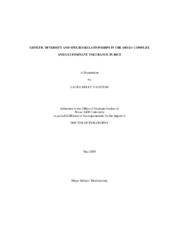| dc.description.abstract | The weed red rice is a major problem in rice producing areas world wide. All of the red rice in
commercial rice fields in the United States has traditionally been considered to be the same
species as commercial rice, Oryza sativa. However, using DNA markers it was found that most
of the red rice with black hulls was sufficiently divergent to be considered a separate species.
This includes TX4, a red rice ecotype that has been reported to have considerable natural
tolerance to the herbicide glufosinate.
TX4 is closely related to samples that have been classified as Oryza rufipogon. However, it was
shown that both the TX4-like red rice from commercial fields and most of the Oryza rufipogon
accessions in the US National Small Grains Collection are more accurately classified as Oryza
nivara. This is significant since Oryza rufipogon is regulated under the Federal Noxious Weed
Act, while Oryza nivara is not.
Oryza nivara closely related to TX4 was found to be widely distributed across the rice
production areas of Texas and was also found in Arkansas, Louisiana, and Mississippi. Of 240
samples from across Texas, 23 samples from six different counties were identical with TX4 with
all 18 DNA markers tested.
The reported glufosinate tolerance of TX4 is a potential problem since this same herbicide would
be used in conjunction with genetically modified (GM) that is being developed as a method of
red rice control. Thus, field, greenhouse and tissue culture studies were conducted to evaluate the
degree of glufosinate tolerance in TX4. TX4 typically was severely damaged by glufosinate, but
not efficiently controlled. Even with the maximum number of herbicide applications at the
proposed maximum label rate, TX4 often re-sprouted and produced viable seed. Herbicide
tolerance was found to be variable, but appears to be sufficient to present a problem with the use
of the GM glufosinate resistant varieties currently under development, particularly when
combined with variation in the response of ??sensitive?? varieties. | en |


